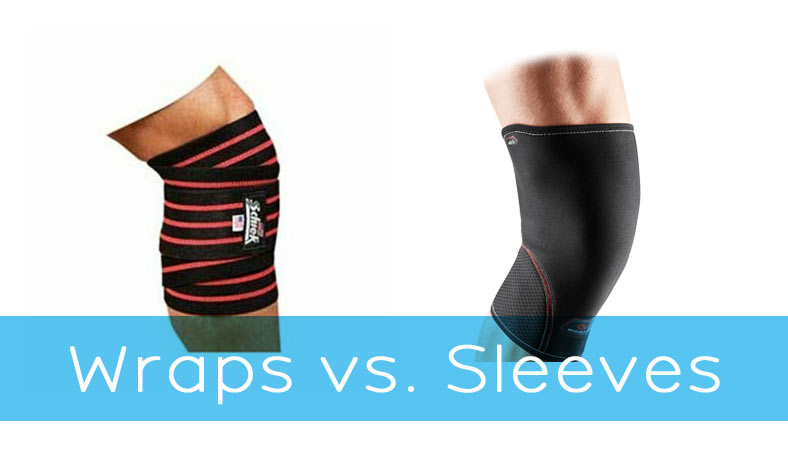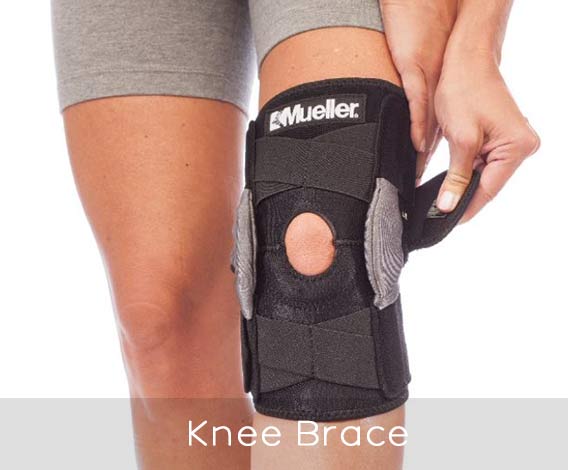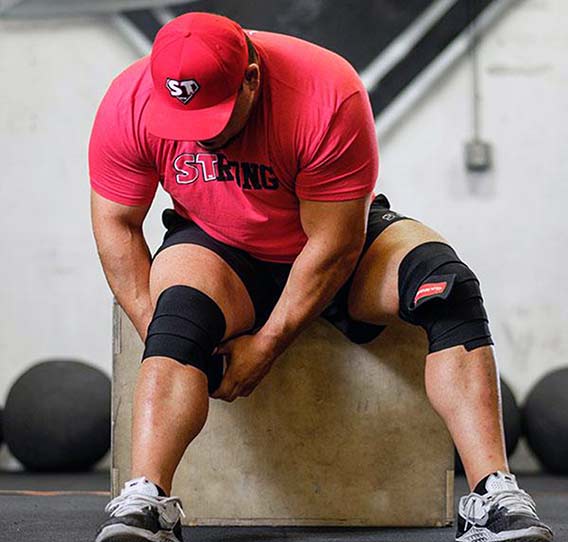If you love squats, you know just how much pressure this exercise can put on your knees. Many believe there’s no better legs exercise than the classic squat.
But in time, squats can lead to knee injuries for different reasons. Constantly increasing barbell weights can hinder your knee joints.
Even repetitive squatting with no weights can impact your knees. But by far, the biggest cause of concern comes from incorrect squatting position which leads to all types of knee problems.
Most of the postural issues can be dealt with using knee wraps and knee sleeves. But not many know how to use them correctly.
If you love squats, both knee wraps and knee sleeves can be helpful, with the condition that you know how to properly use them.
This article looks into how the knees work and why you might choose knee wraps over knee sleeves.

Contents
- 1 The role of the knee – why it’s important
- 2 Using knee wraps and knee sleeves to mitigate knee injuries
- 3 When to use knee wraps or knee sleeves
- 4 The advantages of disadvantages of knee wraps and knee sleeves
- 5 How to use Knee Wraps and Knee Sleeves
- 6 Should you wear knee wraps and knee sleeves all the time?
- 7 This is how you choose the best knee wraps or knee sleeves
- 8 Final words and tips
The role of the knee – why it’s important
The knee is the largest joint in the body. It supports flexion, extension, and lateral rotation. Knees allow us to stand and sit. When squatting, knees are the primal joint of the exercise allowing the body to come down and back up being connected to the muscles of the thighs.
The anatomy of the knee
The knee is the joint between the femur and the tibia. It connects muscles such as the hamstrings, quadriceps to the patella and the calves in the lower legs. The knee connects extensors and flexors for both standing and flexing movements.

Cartilages
The knee has 2 main cartilages. The meniscus and the articular cartilage help protect the bones in the knee area. The knee’s meniscus is formed from the medial meniscus and the lateral meniscus.
Bones
3 bones are held in place by the knee joint. These are the femur, tibia, and patella.
Muscles
Muscles aren’t technically part of the knee but they are the reason you do squats. Muscles responsible for the position of the knee involve the glutes, quadriceps, and hamstrings.
The first signs of a knee injury
Common knee injuries are those to the cartilage. Fractures or cruciate ligament injuries are typically severe together with meniscus issues.
Early signs of knee injuries have been inflammatory. Knee inflammation is a simple description given to the overuse of the knee, which is common in those who do squats frequently.
Patella inflammation is highly common. Both a high number of squats and squats under heavy loads can prevent your patella to travel correctly across the knee joint when the knee is flexed.
Potential causes of knee injuries
You might be thinking you are performing squats correctly and that you still get knee pain or knee inflammation. The causes of such injuries are diverse. You might need to travel further down the legs to understand what causes such issues.
Flat feet or a foot that tends to collapse inwards is troublesome for knees. The fact that your foot collapses inwards changes the angle of your knee flexion, leading to potential knee injuries.
Poor hip strength is also troublesome for the knees. Most people training at the gum have poor hip strength. This is one of the areas of the body that tends to get overlooked.
Using knee wraps and knee sleeves to mitigate knee injuries
Using proper squatting shoes with midfoot support as well as exercising hip mobility is crucial. But you can also train your knees to become stronger using knee sleeves and knee wraps.
What is the role of knee sleeves? It’s mostly about the corrective posture of the knee. If your knee tends to collapse or move outwards, knee straps can prevent it from moving to the sides too much. Some people even consider knee sleeves to hit up their knees and prevent squatting without a proper warm-up.
Another aspect of knee biomechanics is given by the feeling of security knee straps and sleeves offer you. This can even lead to adding more weight on your knees than you can normally squat.
The difference between knee wraps, knee sleeves, and knee braces
Knee braces are more inclined towards knee support during and after a knee injury. Knee braces are mostly used for conditions such as minor knee pain, sprains, knee swelling, weak ligaments, pre, and post-surgical knee protection.
Here’s why you need to use knee wraps and sleeves.
Knee wraps and knee sleeves are similar, but they have their differences. You don’t need to choose one or the other as you can use both. In this section, we look at when to use knee support and why these 2 solutions are different.

Should you use knee sleeves?
Knee sleeves work best when they’re tight. You can use them both in training and in competitions (make sure you check rules for your competition). If you are training legs frequently, you need to use knee sleeves for that extra knee support and as an aid for knee alignment.
To put on knee sleeves, you can slide them completely past your shin. You then fold them down all the way until you get a half sleeve that is easy to bring up past the calf. Finally, you unroll the knee sleeve over the knees easier than simply pulling them all the way without folding down.
When to use knee wraps or knee sleeves
You should aim to use wraps and sleeves when you squat alone. The idea of the straps is fine for support of the knees, but it can hinder the circulation throughout the training session. As a result, you can use your knee wraps when you squat and take them off for any other exercises you perform during the workout.
Knee wraps are commonly used by athletes
You might have seen knee wraps on YouTube, but they are often linked to sports such as powerlifting, bodybuilding, and CrossFit. You can also use knee wraps as a fan of fitness, not only for competition. But what are knee wraps?

Made from elastic-textile material, knee wraps are made to wrap and hold the knee tightly. The wrapping method is mainly similar to a spiral. The final result should lead you to feel like your knee can handle more weight as a result of extra support.
Knee sleeves are easier to use
Knee sleeves are the simpler version of knee wraps. Made from compression material, knee sleeves are pulled over the knee and there’s no tying required as with knee straps.

If you don’t have too much time to prepare for squats, knee sleeves can be the quicker solution for extra knee support.
The advantages of disadvantages of knee wraps and knee sleeves
When you’re after the best squatting performance, you need to know what to expect with each of these systems. While you can use both knee support products, you might only be interested in investing in one of them. Here’s where they shine and where they fall short.
4 Advantages of knee wraps
- You lift more weight – when you use your knee wraps correctly, you get to lift more weight. Each time you go down with the squatting exercise, you get to use the momentum or energy stored in the wrap to come back up a bit more efficiently.
- Reduced stress of the quadriceps tendon – every time you sit or squat, the quadriceps tendon pulls the kneecap. This is then going to prove a bit less stressful on the tendon while wearing knee wraps.
- Easy to wash – all knee wraps are easy to wash. You will need to wash them to get rid of sweat and bacteria. But as with most fitness accessories, this becomes easier when you can add them to the washing machine.
- Highly durable – Knee wraps tend to be a bit more durable than knee sleeves. You might have noticed sleeves becoming loose in time. But this isn’t an issue with knee wraps which almost always grip the knee at a different point which also means their fibres tend to last longer before becoming loose.
4 Advantages of knee sleeves
- Compression to reduced knee inflammation – as seen above, knee inflammation is one of the main first signs of a knee injury. You can reduce knee inflammation by wearing knee sleeves, especially when you squat frequently.
- Limited patella movement – with limited patella movement, knee sleeves improve your squatting position. They even limit lateral movements, which can also be one of the main causes of injury when squatting.
- Easy to use – unlike knee wraps, knee sleeves are very easy to use. You step into each of them and you simply pull them up over the knee.
- Added warmth in cold weather – injuries in cold-weather training are frequent. If you want to prevent them, you need to ensure your joints are thermally protected and knee sleeves are perfect for this purpose.
The disadvantages of knee wraps and how to solve them
Not everything is perfect with knee wraps and you need to know how to make the most of them make some gains from your first workouts.
Limited strength gains
Knee wraps don’t necessarily come with large strength gains from the beginning. Many expect to be able to lift a lot more with these wraps but some bodybuilders argue the strength gains are limited to around 5-10%.
Possible patella discomfort
Since the wraps are tight around the knees, they can push the patella against the knee. This is why it can be dangerous to associate knee wraps with exclusive knee protection. You need to wrap your knee so that you don’t feel discomfort in your patella.
The disadvantages of knee sleeves how to solve them
Knee sleeves are easier to wear, but they can be troublesome in some areas. For example, they can give you a false impression of strength.
Bad odour
Knee sleeves are typically made from neoprene. Sweat particles tend to bound to the neoprene which means there are plenty of reasons to wash them more frequently than knee wraps made from other materials.
Marginal posture improvements
Knee sleeves use compression principles. However, strength gains aren’t as prominent as many would expect while wearing them as with knee wraps. But posture is an area you still have to work on even while wearing knee sleeves.
How to use Knee Wraps and Knee Sleeves
If you’ve never used knee wraps and sleeves, you’re in for a treat. Putting both of these on can feel like a special occasion and it may even work as extra motivation to get you into training.
How to wrap your knees for squatting
When you decide to use knee straps, you need to know how to put them on yourself.
This is why you start at the bottom working your way up the leg. You roll the wraps a couple of times under the knee, a couple of times over the knee, and a couple of times over the knee.
You then bring the wrap down diagonally tying it or securing it at a patella level in the middle of the knee for the most support.
How to put on tight knee sleeves for squatting
Knee sleeves are very easy to put on. However, the easier they are to put on, the higher the chances of them being loose are. Here are a few good tips on how to put on knee sleeves.
- Roll the top of the sleeves and pull
Raising the knee sleeves over the knees is easy with rolling. The top side of the sleeve can be rolled so that you have something to pull on. You then get the chance of getting the knee sleeve over the patella a bit faster.
- Consider long athletic socks
If you still struggle with knee sleeves, it can be a good time to invest in athletic socks. These long and tall socks for sports are normally covering calves completely which means they are slippery and better for knee sleeves. Instead of constantly dealing with sweaty legs which prevent easy knee sleeves roll, you can only deal with socks which are always better for knee sleeves even if they add thickness to your feet.
- Wear leggings
Wearing leggings at the gym is not news anymore. But leggings can also offer a smoother surface to put on knee sleeves faster.
Should you wear knee wraps and knee sleeves all the time?
One of the biggest causes of concern with knee protection is timing.
Since they restrict blood flow from the upper leg to the lower leg, you want to limit the amount of time you wear them in any given session.
Even if you train legs on a given day, you don’t need knee protection for exercises such as calf extension or hamstring curls. You only use knee support for squats.
This is how you choose the best knee wraps or knee sleeves
When you want to choose the best knee wraps, you need to know what to look for as most products on the market aren’t made to last.

Consider your sport
One of the biggest questions to ask before making a purchase is which type of sport are you looking to practice? Most sports with squats are similar but they have their differences.
- CrossFit
CrossFit requires you to perform multiple movements and you are highly likely to go for a higher rep count with squats than in bodybuilding. As a result, knee sleeves that aren’t as tight might work for CrossFit. When you perform as many reps as possible such as 50 squats in a minute, you do the exercise with lower weight, and knee flexibility is crucial.
- Bodybuilding
Bodybuilding-style squats are performed in 8-12 repetitions usually. It’s here that you need more support and enhanced abilities to lift more weight by progression. You should choose knee sleeves or wraps that are easy to readjust if you love bodybuilding.
- Powerlifting
Powerlifting usually involves even fewer repetitions. You can do as few as 2 repetitions when powerlifting. Lateral support and patellar support are essential in powerlifting. Very tight knee wraps are preferred (consider going down a size) together with loose knee wraps which can be wrapped very tight around the knees to help you deal with a large amount of weight on the knees. Here are a few quick recommendations for your knees depending on your sport.
Knee wrap – powerlifting, strongman, bodybuilding
Knee sleeves – bodybuilding, CrossFit, cross-training
Consider your training purpose
In general, knee sleeves are made with variable thicknesses. Knee sleeves with a thickness of up to 5mm are recommended for functional training and bodybuilding. If you’re interested in powerlifting, you will need knee wraps that are at least 7mm thick.
Consider restrictions
Not all competitions allow knee wraps and sleeves. Some of them even specify the dimensions knee protection can have. For example, the International Weightlifting Federation only allows knee sleeves and wraps to cover up to 300mm of the skin. Make sure you check the rules in your competition for the squats you perform above amateur level. You can choose whatever knee wrap you feel comfortable with when training at the gym.
Materials are important
The materials of the knee wraps and sleeves are crucial for support and durability. You can find them in almost any material as they are even made from recycled textiles. However, most of them are made from the following materials.
- Neoprene
Neoprene is easy to manufacture and affordable for the end-user. You can find neoprene knee sleeves for any sport such as cross-training and powerlifting. Easy to use, these neoprene knee wraps are perfect for everyday use.
- Cotton, polyester, and elastomer
Multiple materials can be used at the same time to create the ultimate knee wraps and knee sleeves. This is why it’s important to find products that feel good but which also offer proper structural support.
Cotton is used in different blends such as polyester and flexible elastomer. You can find most knee sleeves or wraps are made with these materials in different percentages.
- Classic knee wrap
The classic knee wrap is made with a 1-piece design. It normally has a length between 70 and 82 inches. But the length of the knee wrap is subjective. You can add support to your knee with any type of wrap in this length range.
- Hook and loop knee wraps
Hook and loop knee wraps and knee sleeves tend to be a bit more practical. They resemble classic knee wraps and knee sleeves but they come with added Velcro straps. Made for easier fastening, these straps tend to be the most useful when it comes to everyday use.
- Knee sleeves
Knee sleeves are made from elastic materials. They can be seen as top choices for those who need simpler knee protection. Putting on knee sleeves only takes a few seconds when compared to knee wraps.
Final words and tips
Using knee wraps and knee sleeves can seem daunting when you don’t know what you’re doing. But they can provide heat to keep injuries away as a bare minimum if not proper knee support when worn correctly. Squatting is not problematic on the knees without weight but when you add plates on the barbell, things can deteriorate quickly.
The ideal use of knee wraps isn’t hard to master if you know how to put them on. But you might also consider knee sleeves that tend to be even easier to wear. A final tip about sizing should also be considered. Today, knee sleeves are available in small, medium, large, and extra-large sizes. A medium-sized knee sleeve is typically designed for thighs with a circumference between 17 and 19.5 inches. Make sure you read the manufacturer’s description to find the right size knee sleeves for you.
Knee wraps are made with a universal fit. Regardless of its length, you can still wrap your knees with a knee wrap. Both knee wraps and knee sleeves can also come with extras which might help them fit better. If you struggle to keep them in place while squatting, you can consider knee wraps and sleeves with anti-slip silicone inserts. They generally stay in place better, even on sweaty knees. Most importantly, knee wraps and sleeves protect your feet. You use them to stay away from health issues such as knee inflammation, joint stiffness, and swelling. Other benefits include faster muscle recovery and possibly the ability to lift more weight.
Chris Jordan
Hey there, I'm Chris Jordan! I'm a certified personal trainer and dietician with over 11 years of experience in the fitness industry. I've helped thousands of people achieve better physical and mental health. When I'm not working, I love spending time with my dog.



![How to clean adjustable dumbbells? [e.g. Bowflex and PowerBlock]](https://lafitness.reviews/wp-content/uploads/thumbs_dir/how-to-clean-adjustable-dumbbells-20hj5my2115uuagb8wtleoeoy6iq4hluixjutukgq84k.jpg)
![What Weight Kettlebell Should A Woman Use? [Potential Risk]](https://lafitness.reviews/wp-content/uploads/thumbs_dir/kettlebell-weight-20h09n1ob4qpwvg2czx13h5puovp8ffodpar6eae049w.jpg)
![Focus T25 Workout Schedule: Free Calendar and PDF [Video]](https://lafitness.reviews/wp-content/uploads/thumbs_dir/focus-t25-workout-1zexaab0devemj1blzta5ya8wgyalv0bq9qv34ld2v8k.jpg)
